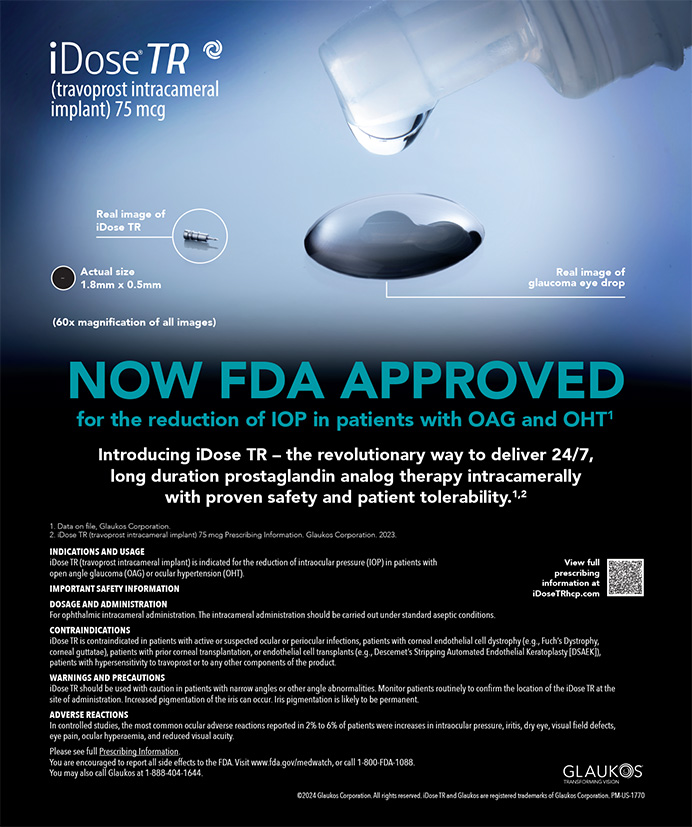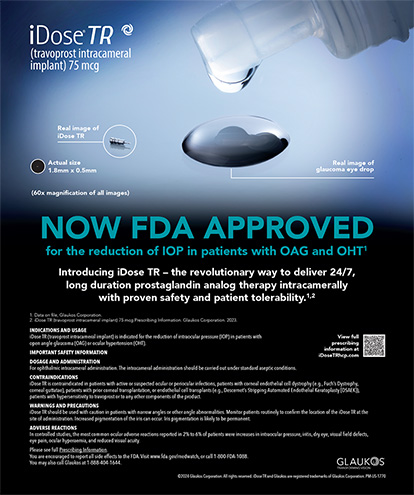The specific description of anterior capsular contraction syndrome was published in 1993, following the widespread adoption of the continuous curvilinear capsulorhexis (CCC).1-4 Unfortunately, this acceptance proves that every medical advance—which the CCC certainly represents—has potentially negative, unanticipated results. Anterior capsular contraction syndrome is a peculiarly frustrating circumstance because the progressive constriction of the capsule that thwarts a "perfect" surgical procedure is seemingly out of the surgeon's control. Extreme phimosis of the anterior capsule's opening can obscure vision (Figure 1), the distortion of the capsule can affect the IOL's position and function, and the progressive contraction can directly result in zonular dehiscence, thus leading to capsular/IOL complex dislocation. Concern about capsular contraction and opacification is of even more importance now in the setting of presbyopia-correcting IOLs. Achieving perfect lens centration, preventing any later tilt or distortion, and maintaining pristine optical quality are all paramount in meeting the heightened expectations of both surgeons and patients in this setting.
PATHOLOGY
It is important to understand the pathology of capsular contraction syndrome. Its etiology—as opposed to that of posterior capsular epithelial cell migration—involves anterior, cuboidal lens epithelial cell metaplasia with myofibroblastic transformation. The altered cells contain smooth muscle actin, and contraction occurs in the resultant fibrous membrane. Anterior capsular opacity and shrinkage usually occur much earlier than posterior capsular opacification (PCO) (eg, within the first 3 to 6 months postoperatively). Studies have shown that some opacity and shrinkage probably occur after every case of cataract extraction.5-7
RELATED MEDICAL CONDITIONS
Several medical conditions can predispose patients to the development of significant anterior capsular contraction syndrome. The best known and probably most commonly encountered of these conditions is pseudoexfoliation. Other pathologies include a history of uveitis, retinitis pigmentosa, high myopia, myotonic dystrophy, advanced age, and trauma (including ocular surgery). Subtle zonular damage, which most likely occurs from previous surgery such as trabeculectomy or vitrectomy, allows for progressive changes after cataract extraction in some cases. Diabetes mellitus is sometimes implicated in this condition as well, although this relationship appears to be less direct. It is certain, however, that zonular disease or trauma is closely associated with the problem of pathologic capsular contraction. Also, instability of the blood aqueous barrier appears to be an inciting factor in pathologic capsular contraction. A history of any of these situations should alert the surgeon to approach the procedure with caution and consider surgical techniques.8-11
CREATING A LARGE CCC
Surgically, it would be logical that creating a larger CCC opening would address the concern of progressive contraction. Although a larger opening does not eliminate the contraction effect, a wider visual aperture adds a margin for retaining good unobstructed vision, even with some degree of capsular phimosis. I advise that surgeons pay particular attention to making the CCC as large as possible (within limits of the IOL's optic margin) in situations of known increased risk.
REMOVING ANTERIOR LENS EPITHELIAL CELLS
Investigators have shown conclusively that careful removal of the anterior lens epithelial cells reduces anterior capsular opacity and constriction. Although there may be a trade-off due to a reported increased tendency toward PCO with the removal of the anterior lens epithelial cell removal, this exchange would seem worth the extra effort in conditions such as pseudoexfoliation. Such maneuvers at times are difficult in the setting of obvious zonular weakness, but surgeons should attempt them.12,13 Care must be taken not to create stress on the zonules, especially in areas of dehiscence, and curettes or diamond-finished tips, which polish the anterior capsule, are probably preferable in this setting, rather than using an I/A handpiece, which may place tension on the capsule and zonule.
IOL DESIGN AND MATERIALS
Many researchers have analyzed the influence of the IOL's design and material on capsular behavior. Anterior capsular contraction occurs most frequently and is most pronounced in patients with silicone-plate IOLs. In consideration of lens optic material alone, silicone has higher anterior chamber contraction rates than acrylic.14-17 Investigators have also studied haptic material and found that prolene haptics are more often associated with the syndrome than PMMA haptics. Studies' results vary in terms of whether three-piece or single-piece acrylic IOLs have the lowest overall rate of contraction. Furthermore, having a square-edged optic design is more important for preventing PCO than for influencing the anterior capsule's behavior. Surgeons should carefully consider those patients at risk for the syndrome of capsular contraction before selecting a presbyopia-correcting IOL.14-17
CAPSULAR TENSION RINGS
With the introduction of capsular tension rings (CTR), surgeons expected these devices to prevent contraction of the capsular bag. There is evidence that a CTR centers the capsular bag despite weak zonules, stabilizes the IOL's position in the bag, and is effective in controlling severe capsular contraction.18-23 Experience has shown, however, that a nonsutured CTR does not guarantee protection against progressive zonular dehiscence occuring, especially in cases of pseudoexfoliation (Figure 2). Surgeons are now reporting complications of subluxation or dislocation of the IOL/bag complex years after what appeared to be stable surgery using CTRs.18-23 Currently, there is reason to consider utilizing only sutured CTRs or capsular tension segments for high-risk patients, with the caveat that the device's insertion itself is traumatic to the zonular support.
CLINICAL FOLLOW-UP
One of the best forms of prevention against capsular contraction syndrome after the appropriate surgical precautions have been observed is the clinical follow-up of patients who are at an increased risk for the condition. As mentioned previously, the risk of the most aggressive form of this syndrome is highest in the first 3 to 6 months after cataract surgery. The first evidence of this problem is seen either by direct visualization of the capsule at the slit lamp or by changes in the IOL's position and resultant shifts in refraction. If surgeons note apparent contraction of the anterior capsular opening, they should perform relaxing radial incisions around the margin of the capsulorhexis with an Nd:YAG laser. If done early enough, this treatment will usually alleviate the capsular force on the lens implant and zonules.24
In some cases of capsular contraction syndrome, the thickened fibrotic tissue may become so dense that radial incisions are impossible. In this instance, surgeons can use an Nd:YAG laser to release the ring of capsular tissue from around the phimotic opening. Uncommonly, the contraction creates such severe deformity that surgeons should remove and replace the IOL. In addition, there is high risk of capsular dislocation and vitreous loss, and surgeons will likely place the replacement IOL in the sulcus, rather than in the badly distorted, fibrotic bag. Preparation for this worst-case scenario is prudent in surgical planning when faced with the aforementioned challenges.25-29
The problem of progressive zonular dehiscence despite all preventative efforts is the most serious complication of capsular contraction syndrome, although investigators have reported that dehiscence can occur without evidence of pathologic contraction. In either case, this complication demands surgical intervention. If evidence of capsular/IOL instability is identified, the surgeon should consider placing scleral sutures. This process is complicated and not without risks, but it is less hazardous than "rescuing" the entire bag/lens complex from the vitreous. The procedure is beyond the scope of this article, but it is elegantly described by Ahmed et al.27 For these cases, surgeons should prepare to enlist the participation of a posterior segment specialist if necessary.
CONCLUSION
The preparations and actions that will best help surgeons avoid capsular contraction syndrome include knowledge of the syndrome, awareness of high-risk conditions, selection of the appropriate IOL, consideration of CTRs, segments, and suture placement, meticulous surgery including capsular lens epithelial cell cleanup, and vigilant observation of the patient for early detection and intervention. These strategies will help avoid the most serious complications of anterior capsular contraction syndrome, which can confound the surgical outcome, leaving both the physician and patient disappointed.
Priscilla Arnold, MD, is Past President of the ASCRS. She may be reached at ppa@mchsi.com.


